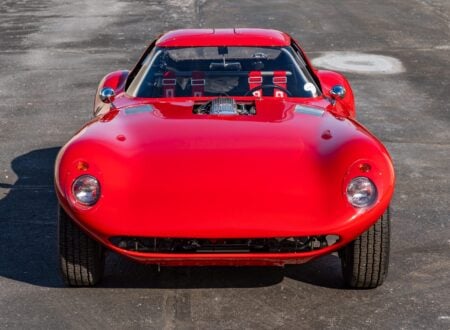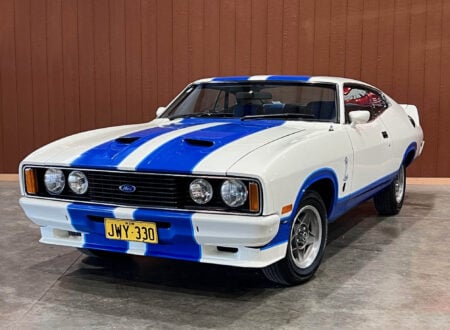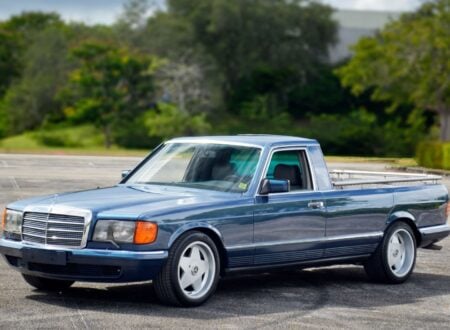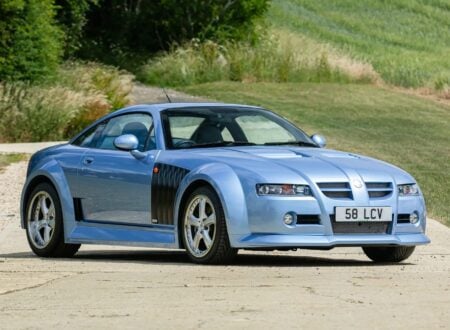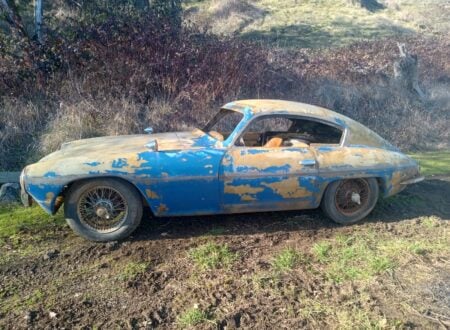This is a rare Glas 1700 GT, it’s one of the last built in 1967 before production shifted over to the BMW version of the model. This one has been sitting in a garage for nearly 50 years and all but forgotten.
The Glas 1700 GT was the larger-engined and more powerful successor to the earlier Glas 1300 GT. The 1700 version was powered by a 1.7 liter single overhead cam inline-four sending power to the rear wheels. It was an elegant, lightweight sports car that could be daily driven, with beautiful styling penned by Pietro Frua.
Fast Facts – The Glas 1700 GT
- The Glas 1700 GT was the successor to the Glas 1300 GT. It debuted in 1965 with a 1.7 liter SOHC inline-four producing 100 bhp, giving it a top speed of 185 km/h (115 mph). It has elegant styling by Pietro Frua, seating for four, and there were options for both coupe and convertible versions.
- Hans Glas GmbH evolved from agricultural machinery to microcars and eventually sports cars, producing models like the Goggomobil and Glas 1700 GT. After BMW acquired Glas in 1966, the 1700 GT was rebranded as the BMW 1600 GT, marking the transition of Glas designs into the BMW lineup.
- The Glas 1700 GT’s lightweight build, OHC engine, and timeless Italian design made it a standout among mid-1960s sports cars. Approximately 5,000 Glas GTs were built, including 363 convertibles, before production ended in 1968 with the BMW-badged models.
- This particular 1967 Glas 1700 GT, a garage find, has been stored untouched for nearly 50 years. Finished in yellow with a complete engine, transmission, and interior, it requires restoration and is currently being offered for sale on eBay from Salinas, California.
Hans Glas: From Steam, To Microcars, To Sports Cars
Hans Glas GmbH was founded by mechanic Andreas Glas in 1883 as an agricultural machinery repair company in Pilsting, Germany. The company’s first name was the delightfully logical Andreas Glas, Reparaturwerkstätte für landwirtschaftliche Maschinen mit Dampfbetrieb, meaning “Andreas Glas, repair shop for steam-powered agricultural machines.”


The company grew over the years and by 1905 Glas developed his own crop sowing machine which he put into production. Production numbers would climb, and within a few years Glas was building over a hundred machines a year.
After World War II the company was renamed Hans Glas GmbH and initially, it began producing the kind of small, fuel-efficient vehicles that were very much in demand across post-WWII Europe – microcars and scooters. The most famous of the Glas microcars was the Goggomobil which was built in sedan, van, and coupe variants.
By the late 1950s consumer tastes were changing in line with their increasing spending power, and as a result Glas began manufacturing larger and larger cars, starting with the Glas Isar series, then moving on to the Glas 1000 series, the Glas 1300 GT, the more powerful Glas 1700 GT, and finally in 1963 to the Glas 2600 V8 – an elegant grand tourer designed to compete with the likes of Audi, BMW, and Mercedes.
The Glas 1700 GT
The Glas 1700 GT made its debut in 1965, it had been developed to resolve one of the key complaints about the earlier 1300 GT – a lack of power. The SOHC 1.3 liter Glas inline-four was capable of 74 bhp giving the car a top speed of 170 km/h (106 mph).
Although a speed of over 100 mph was considered adequate by most in the mid-1960s when the model debuted, it wasn’t enough for some. A new version of the engine was developed with longer cylinders, resulting in a longer stroke. The displacement was now 1.7 liters and power output increased to 100 bhp, boosting the top speed to 185 km/h (115 mph) with very little in the way of extra weight.


The Glas 1700 GT shared the same styling as the earlier 1300 GT model, done by Pietro Frua and his team based in Northern Italy. The car has long been praised for its good looks, appearing almost like a slightly smaller version of the timeless Italian GT cars of the era.
The car rode on independent front suspension with coil springs, and a live axle on leaf springs in the rear – a common arrangement for the time. The car could be ordered in both hardtop coupe and convertible versions, both with seating for four and a modest amount of trunk space.
After BMW purchased Hans Glas GmbH in 1966 they kept many of the firm’s models in production before slowly shifting them into the BMW family. The Glas 1700 GT followed this route, becoming the BMW 1600 GT in late 1967. The 1600 GT was powered by the 1.6 liter version of the BMW M10 engine previously used in the BMW 1602, and later expanded to 2.0 liters for use in the BMW 2002.
The car would leave production in 1968, with a little over 5,000 Glas GTs made, 363 convertibles, and 1,259 BMW-badged GTs. Today the cars are largely unknown outside of specific classic car communities, and they always seem to attract a curious crowd when they arrive at shows and Cars & Coffee meet ups.
The 1967 Glas 1700 GT Garage Find Shown Here
The car you see here is one of the last examples of the last Glas 1700 GTs that was built before production shifted over to the BMW-badged models. It’s finished in yellow and it’s said to have been repainted around 1975 before being placed into storage and left untouched for almost 50 years.


The car appears complete, with the engine, transmission, and interior all accounted for. That said, the new owner would need to budget for a full re-commissioning and possibly a full restoration.
The car is now being offered for sale on eBay out of Salinas, California with bidding underway now. If you’d like to read more about it or register to bid you can visit the listing here.




















Images courtesy of HeCar_6848




